Section 2 Lectures 1-3
5.0(1)
Card Sorting
1/79
Earn XP
Description and Tags
Cell Division, The Cell Cycle, Mitosis, Meiosis, Mendelian Genetics
Study Analytics
Name | Mastery | Learn | Test | Matching | Spaced |
|---|
No study sessions yet.
80 Terms
1
New cards
What is the mystery of heredity?
* All organisms come from other organisms
* All organisms resemble their parents
* Siblings are not identical
* All organisms resemble their parents
* Siblings are not identical
2
New cards
What did ancient greeks think about parents?
* That males and females must share some “essence” that mixes to produce progeny
* Aristotle thought the “essence” came solely from the male and the female was just a fertile “field” for the essence to grow
* Aristotle thought the “essence” came solely from the male and the female was just a fertile “field” for the essence to grow
3
New cards
What do we know now that contradicts the ancient greeks theory about heredity?
* Parents share sperm and egg (2 individual cells)
* The sperm cells attack one egg, as soon as one gets in the others are blocked
* The sperm cells attack one egg, as soon as one gets in the others are blocked
4
New cards
Classical Cell Theory
* All organisms consist of cells
* Cells divide to produce new cells
* Higher organisms fuse their cells (sperm & egg, pollen & egg) to produce a new organism
* Cells divide to produce new cells
* Higher organisms fuse their cells (sperm & egg, pollen & egg) to produce a new organism
5
New cards
Overview of Cell Division and Growth
* One mother cell divides into 2 daughter cells
* Bothe daughter cells must inherit everything needed to survive
* Including the information of what properties the cell should have
* Bothe daughter cells must inherit everything needed to survive
* Including the information of what properties the cell should have

6
New cards
Chromosome
* A single strand of DNA (a polymer)
* Comes in 2 types":
* Circular (bacterial)
* Linear (most organisms)
* Comes in 2 types":
* Circular (bacterial)
* Linear (most organisms)
7
New cards
Karyotype
* A way of staining/organizing chromosomes that makes the structure clearer
* Chromosomes used for a karyotype only come from dividing cells (only time you can see them)
* Chromosomes used for a karyotype only come from dividing cells (only time you can see them)
8
New cards
Chromatin
* Mixture of DNA (chromosome) and proteins as cell is getting ready to divide
9
New cards
Why can we see chromosomes during cell division?
* Can be seen because as the cell is getting ready to divide, the chromosome condenses by associating with proteins (ex. histones)
* DNA double helix wraps around histones
* Histones keep the DNA tightly packed instead of tangles
* DNA double helix wraps around histones
* Histones keep the DNA tightly packed instead of tangles

10
New cards
How do you make a karyotype?
* Take a cell preparing for division
* Squish it with a microscope slide
* Stain the chromosomes with a dye, take a photo
* Squish it with a microscope slide
* Stain the chromosomes with a dye, take a photo
11
New cards
What can you say about the number of chromosomes in different species?
Number of chromosomes is the same for a species but varies between species
* Bacteria typically have 1, humans have 46
* Bacteria typically have 1, humans have 46
12
New cards
What are identical pairs of chromosomes in eukaryotes called?
In eukaryotes, chromosomes often come in identical pairs called homologs
* Humans have 22 homologs, 2 sex chromosomes
* Humans have 22 homologs, 2 sex chromosomes
13
New cards
What are the duplicates of chromosomes during cell division called?
At cell division each chromosome is duplicated once, the duplicates are chromatids, held together by proteins called the centromere
* One of each pair of chromatids goes to each daughter cell
* One of each pair of chromatids goes to each daughter cell
14
New cards
What are mitotic chromosomes?
* Normally a chromosome is a single piece of DNA
* When looking at a karyotype we see 2 identical pieces of DNA (2 chromatids bound by a centromere)
* This is considered a mitotic chromosome
* When looking at a karyotype we see 2 identical pieces of DNA (2 chromatids bound by a centromere)
* This is considered a mitotic chromosome
15
New cards
Why 2 sister chromatids?
* 2 identical chromatids means the genetic material was duplicated
* So giving each daughter cell one chromatid from each mitotic chromosome means each one will have a complete copy of the genetic material
* So giving each daughter cell one chromatid from each mitotic chromosome means each one will have a complete copy of the genetic material
16
New cards
Segregating Mitotic Chromosomes and Probability
* Unlikely it happens by choice since that would mean both chromatids would have an equal chance of entering either of the two daughter cells
* Thus the probability of each daughter cell getting one chromatid is 50%
* Assuming the segregation of chromatids from different chromosomes is independent, the probability that both cells inherit one chromatid from each of the 46 chromosomes in a human cell, only by chance, is 0.5 ^ 46
* Thus the probability of each daughter cell getting one chromatid is 50%
* Assuming the segregation of chromatids from different chromosomes is independent, the probability that both cells inherit one chromatid from each of the 46 chromosomes in a human cell, only by chance, is 0.5 ^ 46
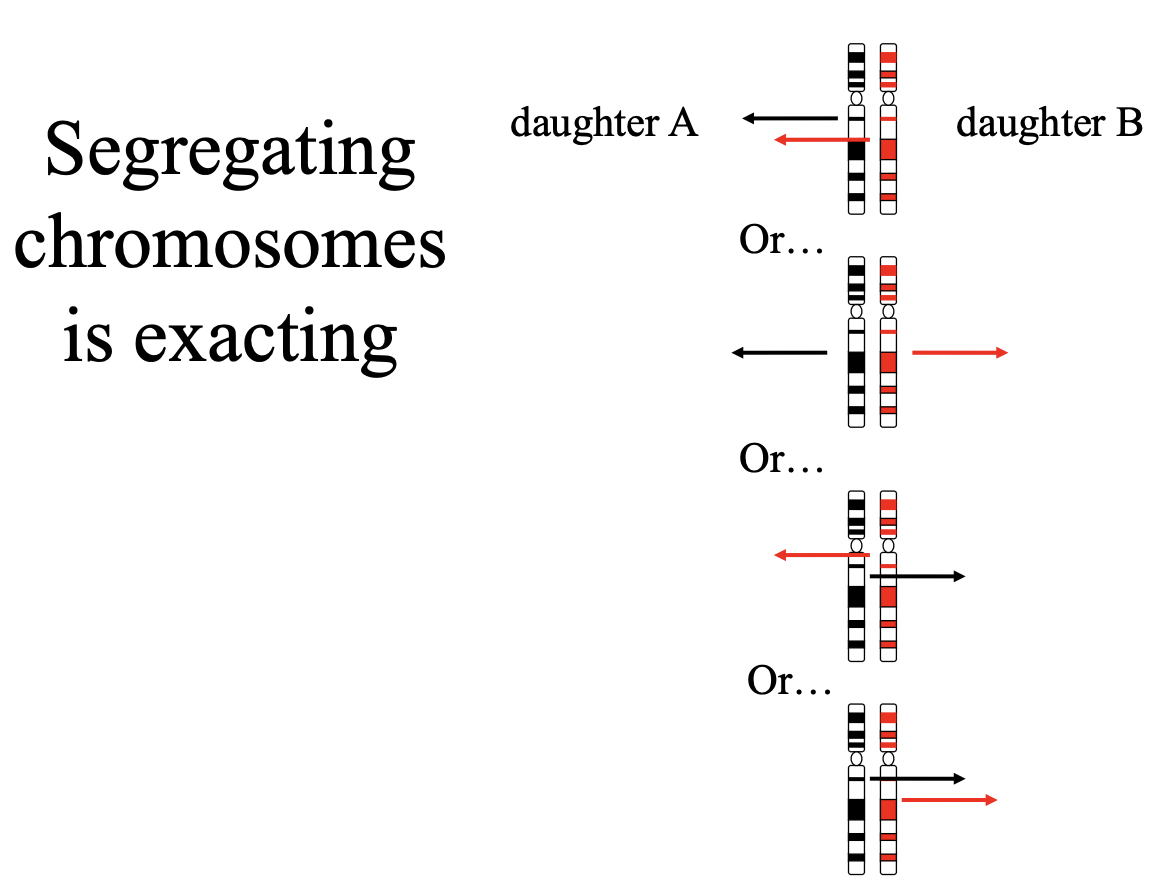
17
New cards
Probability Theory
The probability of 2 independent events is the product of the probability of each event.
18
New cards
Why is chromosome segregation so exact?
* Organisms need at least one of each chromosome, they carry essential genetic material
* Organisms usually need exactly one of each chromosome
* Organisms usually need exactly one of each chromosome
19
New cards
Down Syndrome
* Only case in humans where you can survive past infancy with an extra chromosome
* Results from an extra copy of chromosome 21
* Results from an extra copy of chromosome 21
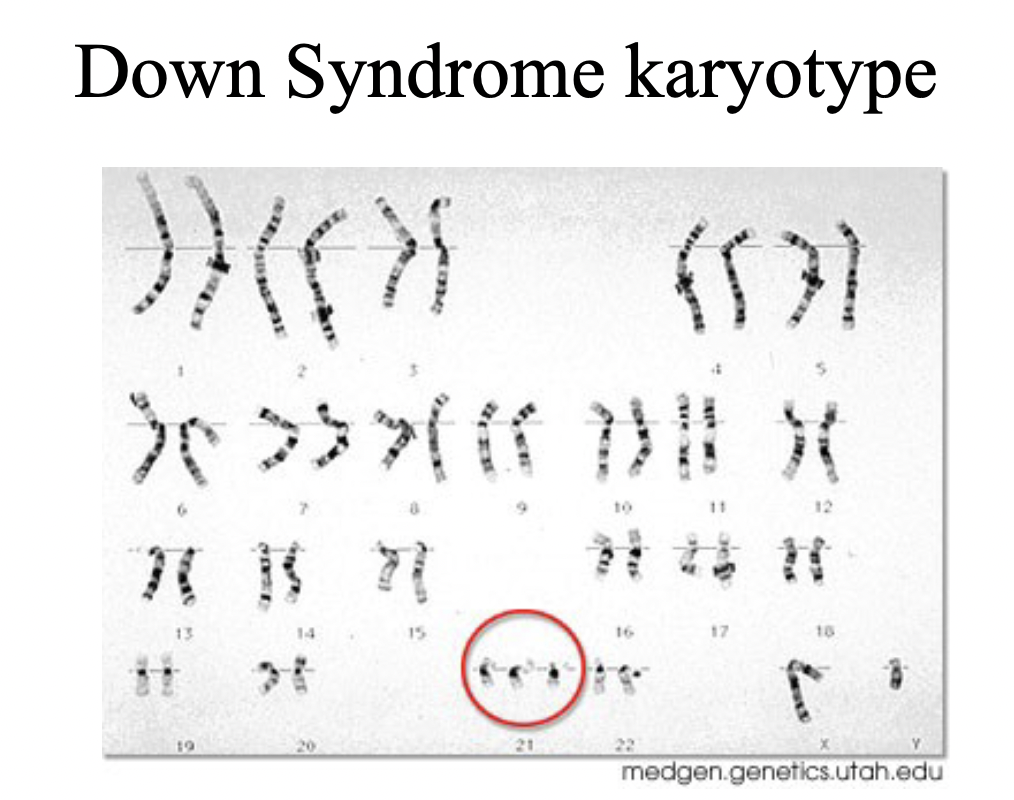
20
New cards
Cell Division - The Cell Cycle Steps
1) S Phase: Chromosome (DNA) Replication
2) M Phase
* Mitosis: Process by which somatic cells make identical copies of themselves, create 2 daughter cells that inherit one copy of each chromosome
* Meiosis: Process by which germ cells make non-identical copies of themselves by creating daughter cells that inherit one copy of each homolog. (i.e. daughter cells end up with half the DNA of the mother cell)
3) Cytokinesis (optional): dividing the cytoplasm in two
Interphase: all phases of the cell cycle excluding M phase
* Between M & S: G1 - cell is resting
* Between S & M: G2 - cell prepares to divide
2) M Phase
* Mitosis: Process by which somatic cells make identical copies of themselves, create 2 daughter cells that inherit one copy of each chromosome
* Meiosis: Process by which germ cells make non-identical copies of themselves by creating daughter cells that inherit one copy of each homolog. (i.e. daughter cells end up with half the DNA of the mother cell)
3) Cytokinesis (optional): dividing the cytoplasm in two
Interphase: all phases of the cell cycle excluding M phase
* Between M & S: G1 - cell is resting
* Between S & M: G2 - cell prepares to divide
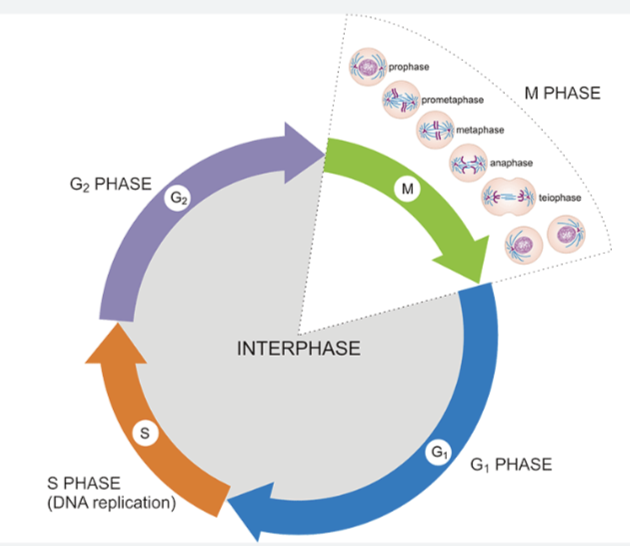
21
New cards
What are Cell Checkpoints
* Checks for the completion of each step before the next occurs
* Ensures that certain conditions are fulfilled before the next phase starts
* Ensures that certain conditions are fulfilled before the next phase starts
22
New cards
Explain the Checkpoint After S Phase
* Between G2 and M
* Ensure a cell does not proceed from G2 unless all DNA has been replicated
* Ensure a cell does not proceed from G2 unless all DNA has been replicated
23
New cards
What happens if you add caffeine and hydroxy urea to the checkpoint after S phase?
* Adding hydroxy urea blocks DNA replication, so the cell never begins M phase because the G2/M checkpoint stops it
* Adding caffeine disables the checkpoint, which normally does not cause an issue and the cell can divide/continue the cycle
* But, if you add hydroxy urea and caffeine the cell enters mitosis and the 2 daughter cells die
* Adding caffeine disables the checkpoint, which normally does not cause an issue and the cell can divide/continue the cycle
* But, if you add hydroxy urea and caffeine the cell enters mitosis and the 2 daughter cells die
24
New cards
Cyclin and Cdk
* Proteins that send signals to the cell
* Does this because when they are joined the cell knows its in G1
* When they are destroyed the cell knows it is not
* This occurs for every step of the cycle
* Does this because when they are joined the cell knows its in G1
* When they are destroyed the cell knows it is not
* This occurs for every step of the cycle

25
New cards
G1/S Checkpoint
* Most cells are at rest in G1
* The checkpoint looks for chemical signals from external cells to determine if the cell should go on to divide (since most cell past G1/S divide)
* The checkpoint looks for chemical signals from external cells to determine if the cell should go on to divide (since most cell past G1/S divide)
26
New cards
Benefits and Negatives of G1/S Checkpoint
* Benefits: cyclin E in mammals become active after pregnancy from hormonal signals and results in the proliferation of breast cells necessary for lactation
* Negatives: something goes wrong with the checkpoint and cells divide at the wrong time (causes cancer)
* For ex. an over expression of cyclin E when not pregnant contributes to breast cancer
* Negatives: something goes wrong with the checkpoint and cells divide at the wrong time (causes cancer)
* For ex. an over expression of cyclin E when not pregnant contributes to breast cancer
27
New cards
Mitosis Key Point
Process that divides up chromosomes equally
28
New cards
Explain G2 in Mitosis
* Replication of the centrosome and centrioles in some cases
29
New cards
Prophase in Mitosis
* Centrosomes move to the poles
* Spindle forms
* Chromosome condensation - chromatids become evident
* Note: here each chromatid is a chromosome even though we refer to the pair of chromatids as a mitotic chromosome
* Kinetochores form
* Spindle forms
* Chromosome condensation - chromatids become evident
* Note: here each chromatid is a chromosome even though we refer to the pair of chromatids as a mitotic chromosome
* Kinetochores form
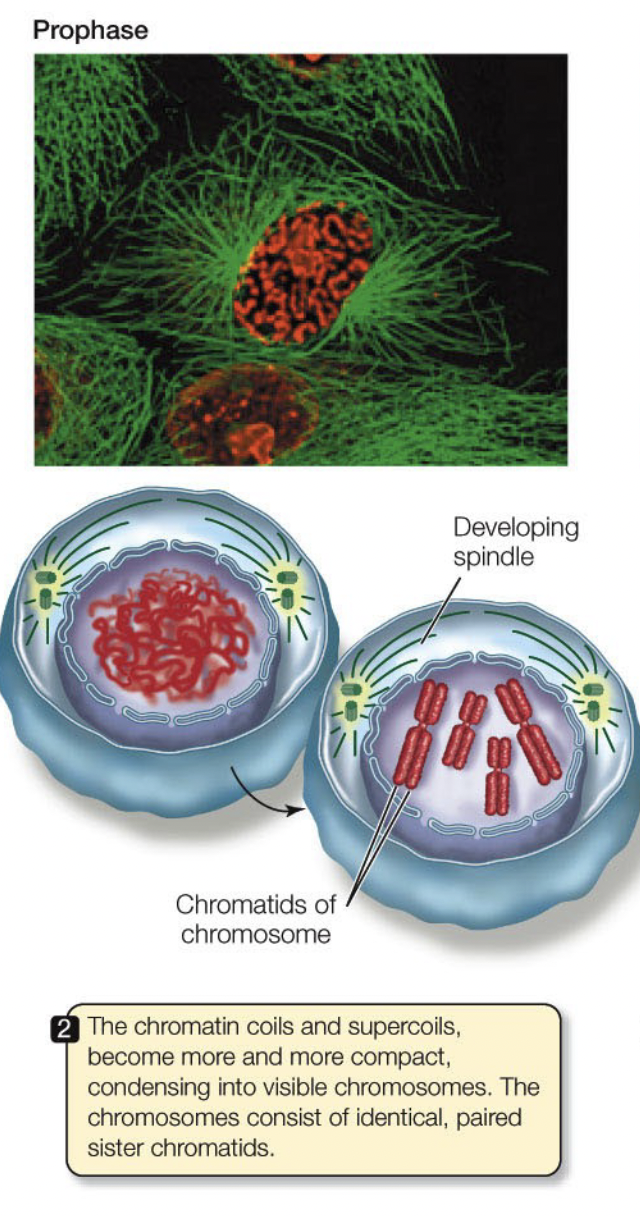
30
New cards
Prometaphase in Mitosis
* Step 2
* Nucelar envelope breakdown
* Polar microtubules and kinetochore microtubules form
* Kinetochore microtubules probe the cytoplasm and attach to kinetochores
* Chromosomes begi
* Nucelar envelope breakdown
* Polar microtubules and kinetochore microtubules form
* Kinetochore microtubules probe the cytoplasm and attach to kinetochores
* Chromosomes begi
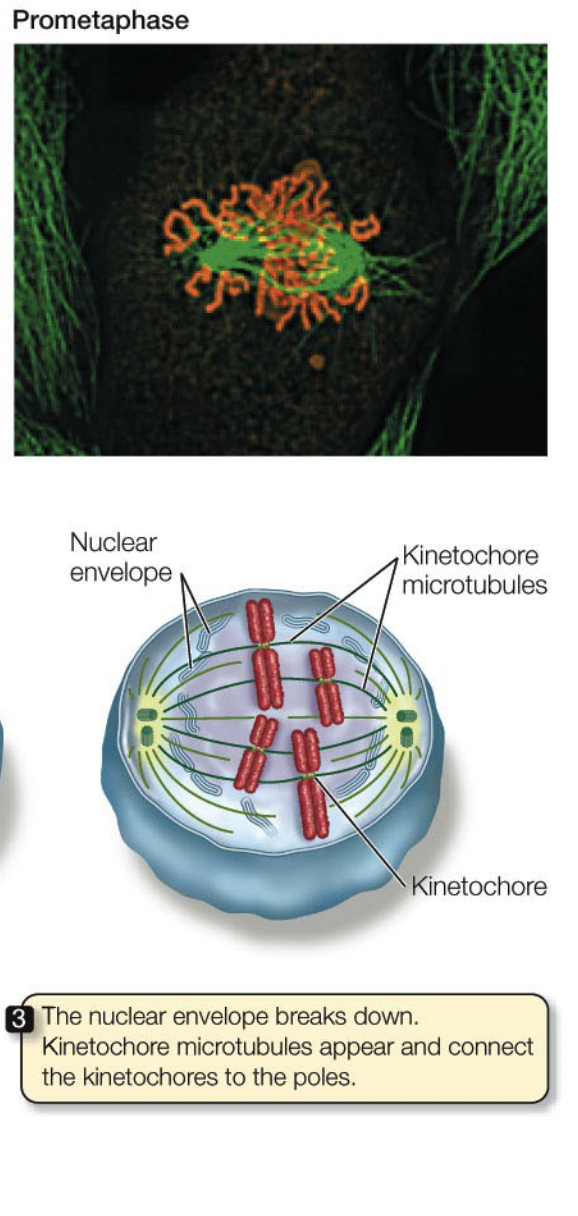
31
New cards
Metaphase in Mitosis
* Sister chromatids bound to kinetochore microtubules on opposite spindles
* Tension from kinetochore microtubules pulling on the sister chromatids, causes them to line up on the metaphase plate
* Tension from kinetochore microtubules pulling on the sister chromatids, causes them to line up on the metaphase plate
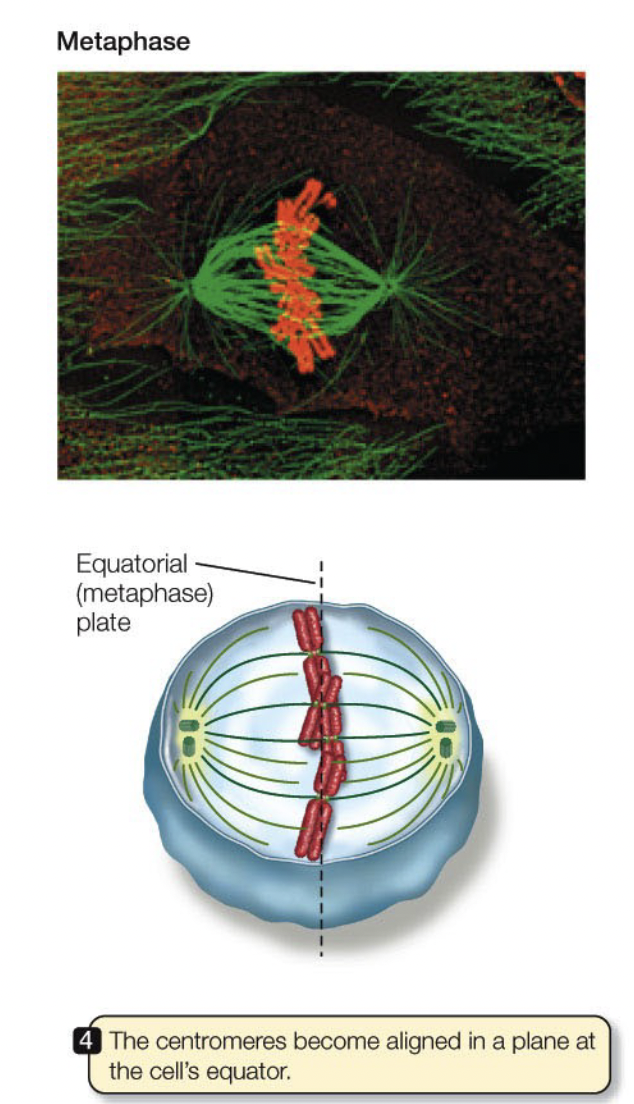
32
New cards
Anaphase in Mitosis
* Centromeres separate
* Kinetochore microtubules shorten
* Spindle elongates
* Kinetochore microtubules shorten
* Spindle elongates
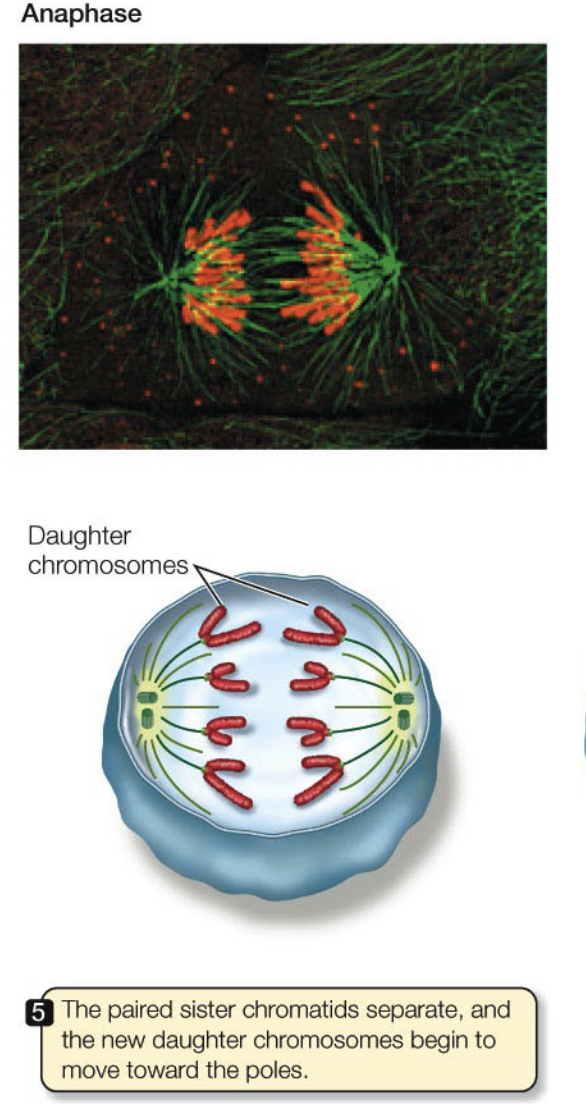
33
New cards
Telophase in Mitosis
* Spindle breaks down
* Chromosomes decondense
* Nucelus reforms
* Chromosomes decondense
* Nucelus reforms
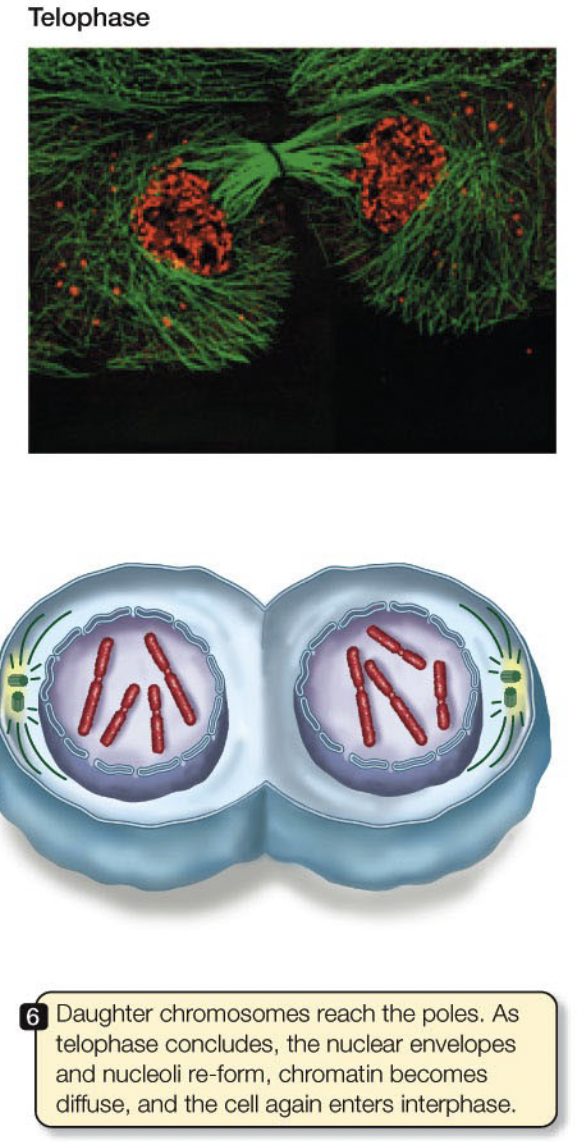
34
New cards
Making a Metaphase Mitotic Spindle
* Keep chromatids paired until all are attached to a kinetochore microtubule
* Have unstable kinetochore microtubules that can grow and probe the cytoplasm and only become stable once captured by a kinetochore
* Make sure 2 kinetochore microtubules from the same spindle can’t capture both chromatids of a chromosome
* Have a checkpoint that senses when all the chromatids have been captured and only then allow the chromatids to separate by dissolving the centromere
* Have unstable kinetochore microtubules that can grow and probe the cytoplasm and only become stable once captured by a kinetochore
* Make sure 2 kinetochore microtubules from the same spindle can’t capture both chromatids of a chromosome
* Have a checkpoint that senses when all the chromatids have been captured and only then allow the chromatids to separate by dissolving the centromere
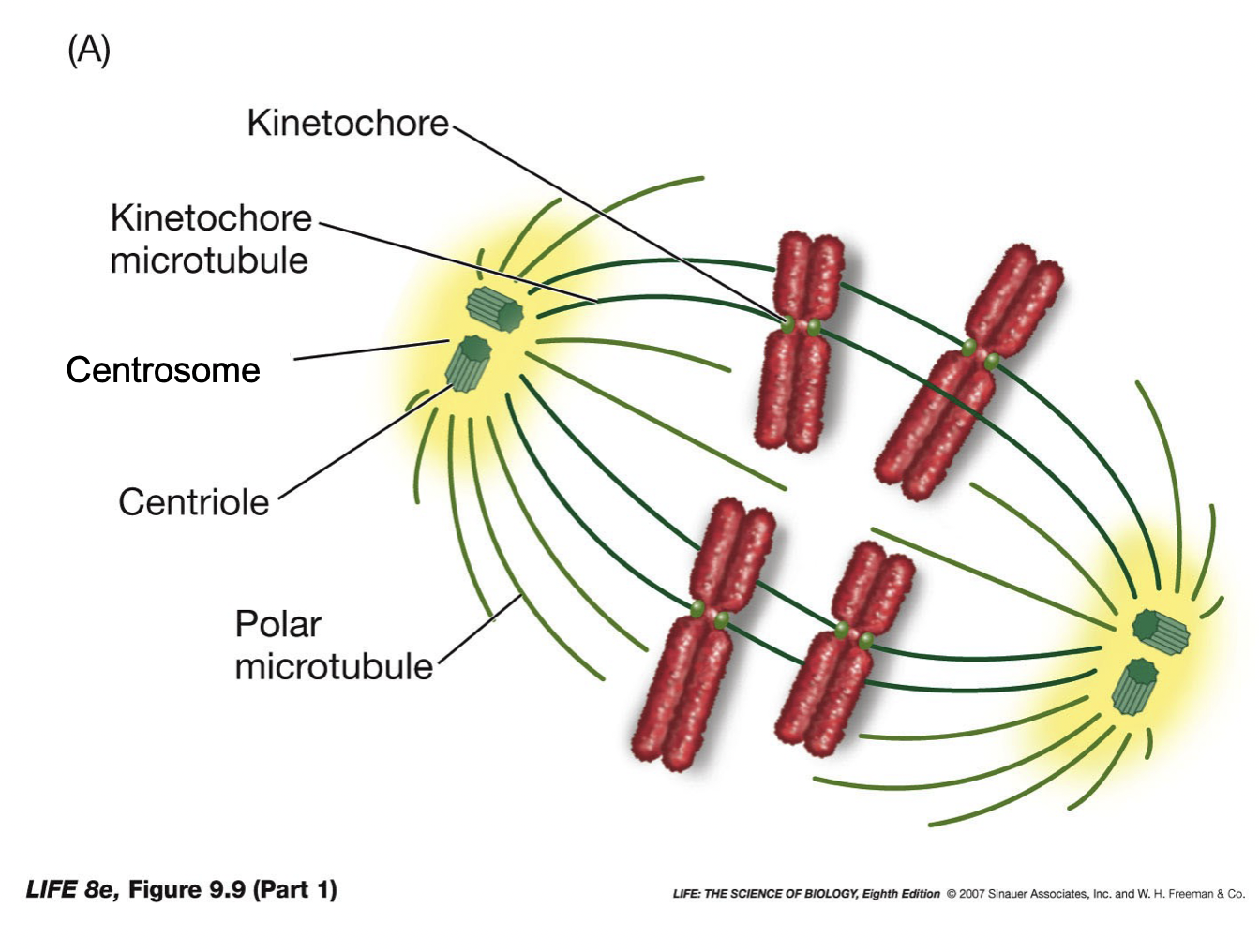
35
New cards
Cytokinesis
* Animals: actin and myosin form a “purse string” that constricts and divides the cell
* Plants: vesicles fuse to make cell membrane and cell plates which eventually becomes the new cell wall
* Process is optional as some cells don’t divide their cytoplasm
* Ex. muscle cells have many nuclei (called syncytial) because they go through mitosis without cytokinesis
* Plants: vesicles fuse to make cell membrane and cell plates which eventually becomes the new cell wall
* Process is optional as some cells don’t divide their cytoplasm
* Ex. muscle cells have many nuclei (called syncytial) because they go through mitosis without cytokinesis
36
New cards
When is mitosis beneficial and why is it considered asexual reproduction?
* Good for clones, i.e. you believe you are perfectly adapted to your environment
* If the environment changes, and you can’t survive neither will your progeny
* No genetic material is mixed, thus asexual reproduction
* If the environment changes, and you can’t survive neither will your progeny
* No genetic material is mixed, thus asexual reproduction
37
New cards
Sex
* Mixing of two organism’s genetic material
38
New cards
Genetic mixing in humans & eukaryotic cousins
* First each chromosome creates a gamete cell that has half the genetic material
* Then the gametes are combined to get an organism with a complete genome
* Then the gametes are combined to get an organism with a complete genome
39
New cards
What characteristics do gametes have?
* Only one homolog of each chromosome
* Ex. sperm an egg cells
* Ex. sperm an egg cells
40
New cards
Ploidy Terminology
* We define n = a set of chromosomes that includes exactly one homolog of each chromosome
* Multiples of n get the names…
* 1n = haploid
* 2n = diploid
* 3n = triploid
* 4n = tetraploid
* Multiples of n get the names…
* 1n = haploid
* 2n = diploid
* 3n = triploid
* 4n = tetraploid
41
New cards
What is the ploidy of somatic cells and gametes in humans?
* Somatic cells = diploid
* Gametes = haploid
* Gametes = haploid
42
New cards
How does entropy tie into chromosomes?
Entropy is responsible for mixing haploid cell chromosomes.
43
New cards
Meiosis Key Point
* Process of splitting chromosomes in half
* First the diploid cell replicates its DNA like mitosis
* Consists of Meiosis 1 and 2
* First the diploid cell replicates its DNA like mitosis
* Consists of Meiosis 1 and 2
44
New cards
Prophase 1 (Meiosis 1)
* DNA beings to compact
* Synapsis: pairing of homologous chromosomes
* Chiasma form; crossing over
* Yields 2 recombinant chromatids
* Synapsis: pairing of homologous chromosomes
* Chiasma form; crossing over
* Yields 2 recombinant chromatids
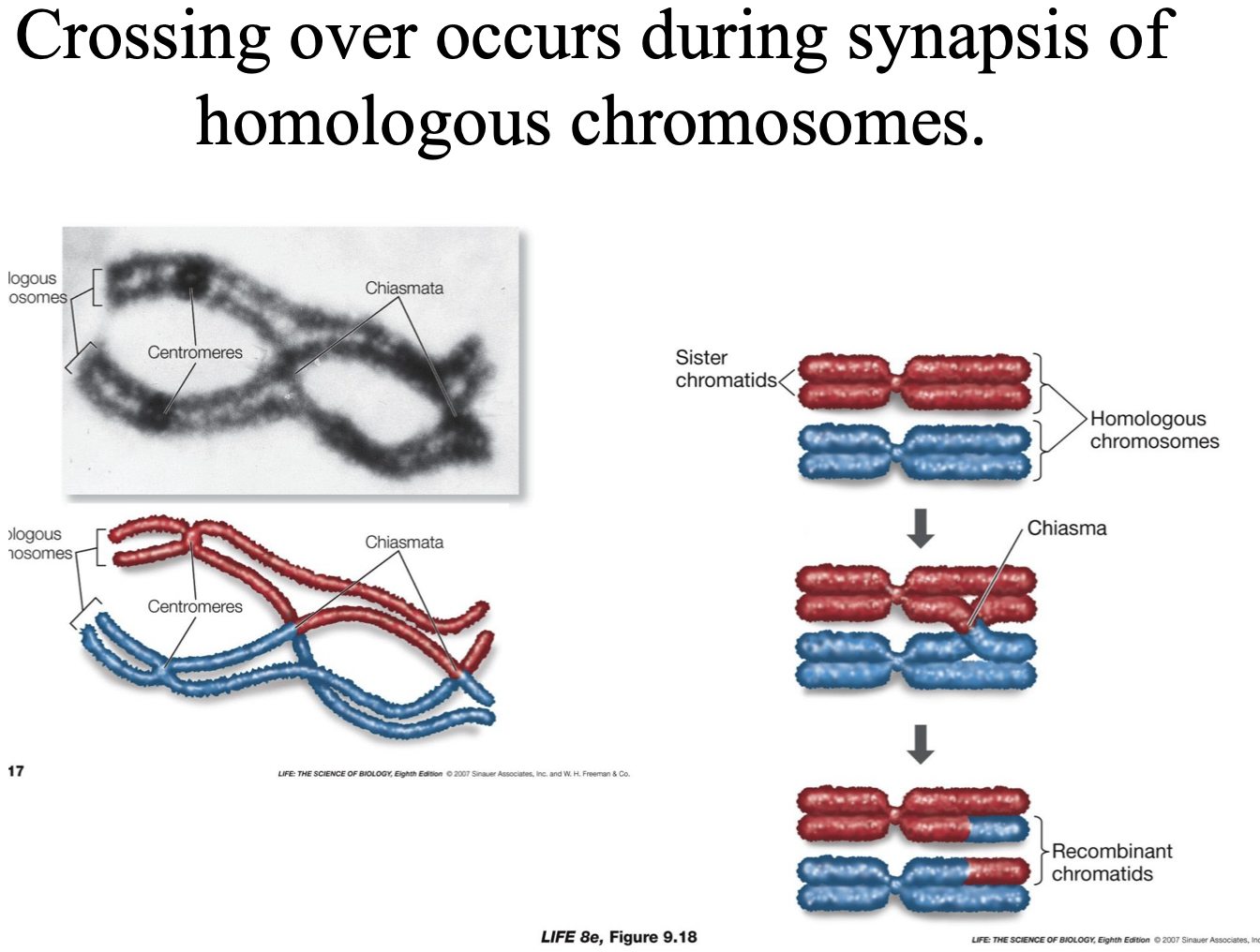
45
New cards
Prometaphase 1 (Meiosis 1)
* Nuclear envelope breakdown
* Spindle fiber forms
* Spindle fiber forms
46
New cards
Mitosis vs Meiosis timing
* Unlike mitosis, meiosis can take a very long time
* Ex. a human female’s eggs begin prophase 1 in utero and finish at ovulation
* Ex. a human female’s eggs begin prophase 1 in utero and finish at ovulation
47
New cards
Homologous Chromosome
* Two chromosomes in a pair
* One from the mother, one from the father
* Have been exchanges by recombination during synapsis
* One from the mother, one from the father
* Have been exchanges by recombination during synapsis
48
New cards
Metaphase 1 (Meiosis 1)
* Microtubules attach to kinetochores, one per homolog (not per chromatid)
* Chromosomes line up at the metaphase plate, held together by chiasma
* Chromosomes line up at the metaphase plate, held together by chiasma
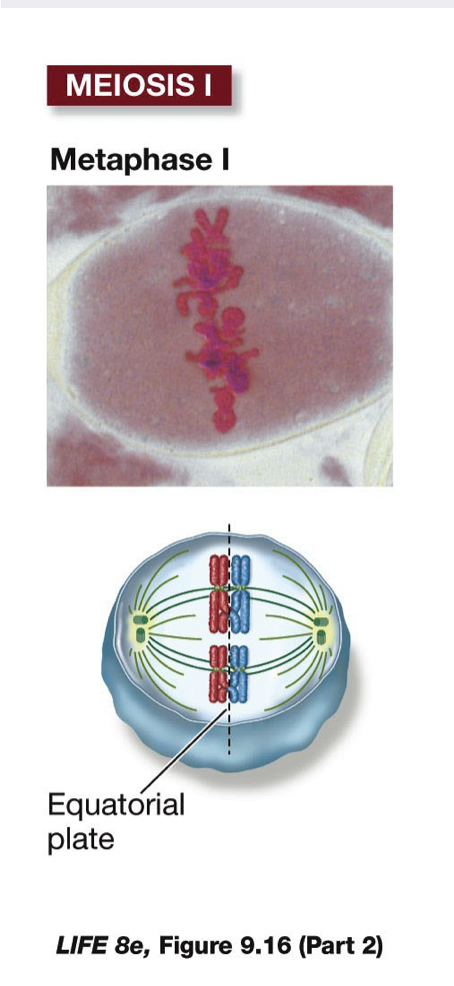
49
New cards
Anaphase 1 (Meiosis 1)
* Separation of homologous chromosomes into 2 separate cells
* Now each ell has two copies (2 chromatids) of each homologous chromosome
* Note: chromatids not identical because of crossing over
* Telophase after this is optional
* Now each ell has two copies (2 chromatids) of each homologous chromosome
* Note: chromatids not identical because of crossing over
* Telophase after this is optional

50
New cards
Meiosis 2 Key Points
* Like mitosis but with half the number of homologs
51
New cards
Metaphase 2 (Meiosis 2)
* Chromosomes line up on plate and chromatids separate to end up in different cells
* Note: the rest of the steps are the same as mitosis
* Note: the rest of the steps are the same as mitosis
52
New cards
Telophase 2 (Meiosis 2)
* Cells split to have 4 haploid cells where each chromosome is just one chromatid
* Results in 4 sperm or egg cells
* Results in 4 sperm or egg cells
53
New cards
Down Syndrome and Meiosis
* Down syndrome is caused by a problem in MEIOSIS not mitosis
* During anaphase 1 of meiosis a non-disjunction event occurs where both chromosome 21 homologs end up in a single gamete (other gamete has no chromosome 21)
* During anaphase 1 of meiosis a non-disjunction event occurs where both chromosome 21 homologs end up in a single gamete (other gamete has no chromosome 21)
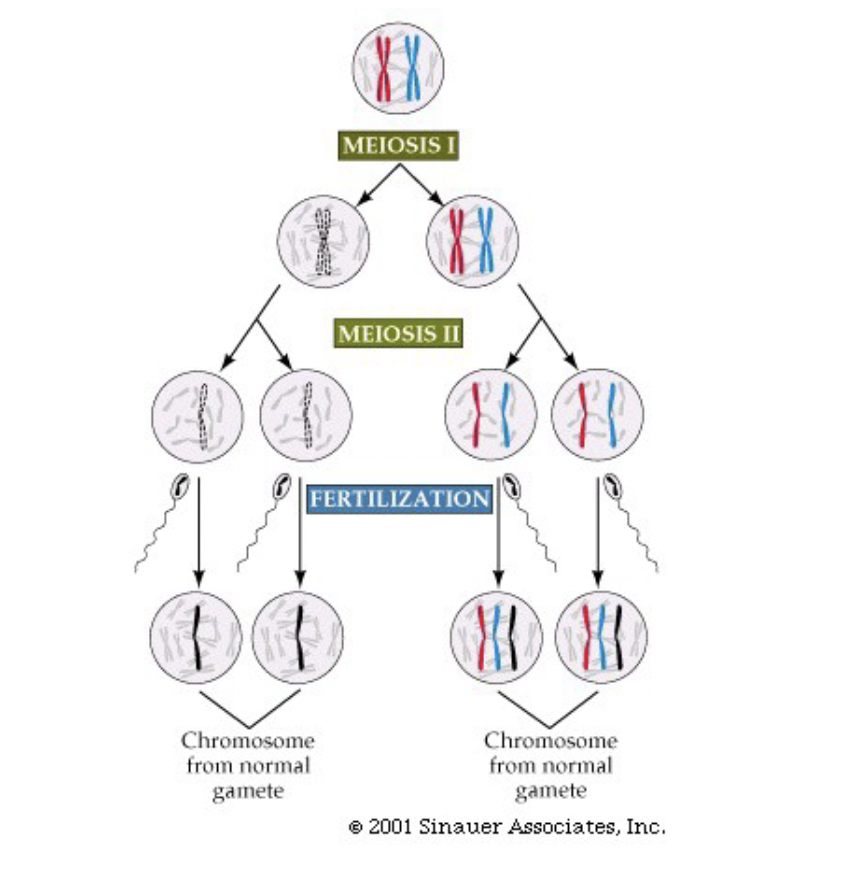
54
New cards
Why does Down syndrome increase in older women?
The frequency of Down Syndrome increases in older women due to how long the eggs have been arrested in meiosis.
55
New cards
Two Ways to Think of Meiosis
1) A diploid organisms divides its chromosomes in the haploid gametes so that when the haploid cells fuse you get back a diploid organism (us)
2) Two haploid cells combine to form a diploid so that the chromosomes can be shuffled before undergoing meiosis to produce another haploid (yeast, molds, etc.)
2) Two haploid cells combine to form a diploid so that the chromosomes can be shuffled before undergoing meiosis to produce another haploid (yeast, molds, etc.)
56
New cards
Importance of Ploidy
* The absolute number of chromosomes is not important, the ratio of homologs is
* Odd ploidys (n, 3n, 5n) tend to be sterile because of problems in meiosis as there are unpaired homologs on the metaphase 1 plate
* Odd numbered ploidy is okay if the cell undergoes mitosis
* Note: Tetraploid organisms are balanced and all homologs can pair with a partner during meiosis 1 (ex. X. laevis frog)
* Odd ploidys (n, 3n, 5n) tend to be sterile because of problems in meiosis as there are unpaired homologs on the metaphase 1 plate
* Odd numbered ploidy is okay if the cell undergoes mitosis
* Note: Tetraploid organisms are balanced and all homologs can pair with a partner during meiosis 1 (ex. X. laevis frog)
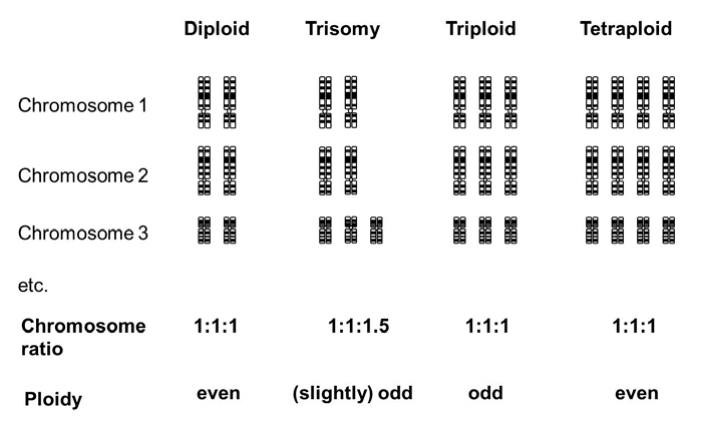
57
New cards
Crop Varieties and Ploidy
* Crops with bigger ploidy are preferred as higher ploidy means bigger fruit
* Ex. strawberries that are octoploid
* Ex. strawberries that are octoploid
58
New cards
Character and Traits - Language of Heredity
* For a given character (height, colour, shape, etc.) offspring share traits (tall, red, oval) with their parents
* Siblings do not have identical traits for a given character
* Siblings do not have identical traits for a given character
59
New cards
Gregor Mendel
* Showed heredity has predictable patterns that result from laws (rules of heredity)
* He did this before the discovery of chromosomes and karyotypes
* He did this before the discovery of chromosomes and karyotypes
60
New cards
Discrete Variation
* There are only two or a few traits for a given character
* Ex. fur colour in mice
* Ex. fur colour in mice
61
New cards
Discrete pea traits, true breeding, and Mendel
* Mendel used peas to test inheritance
* Started with a trait that bred true
* Means that when bred with itself, all the progeny will have the same traits of the characters he was interested in
* Note: true bred/true breeding/ inbred strains are all synonymous
* Started with a trait that bred true
* Means that when bred with itself, all the progeny will have the same traits of the characters he was interested in
* Note: true bred/true breeding/ inbred strains are all synonymous
62
New cards
Mendel’s First Cross
* Crossed a round pea and a wrinkled pea ( w x R ), that always bred true
* The F1 (first filial generation) produced all round
* The F1 x F1 (R x R) bred 3/4 Round and 1/4 Wrinkled
* The result of the second cross was known as the F2 (second filial generation)
* The F1 (first filial generation) produced all round
* The F1 x F1 (R x R) bred 3/4 Round and 1/4 Wrinkled
* The result of the second cross was known as the F2 (second filial generation)
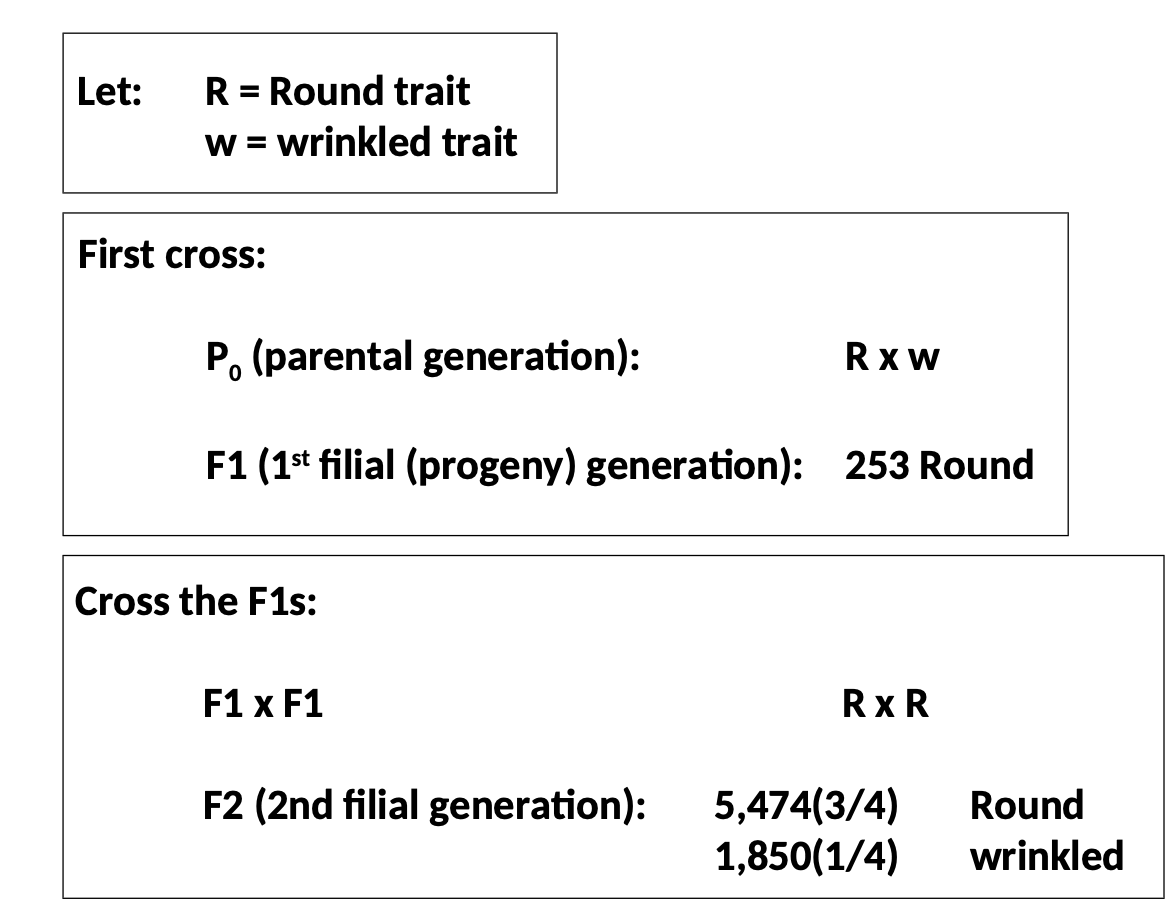
63
New cards
Conclusion of Mendel’s First Cross
* The recessive trait (w) disappeared in the F1
* But showed up in the F2 (second generation) in 1/4 of the progeny
* This applied to other traits too
* But showed up in the F2 (second generation) in 1/4 of the progeny
* This applied to other traits too
64
New cards
Key Takeaway From Mendel’s First Cross
* Always one trait is recessive and reappears in the F2 in 1/4 of the progeny
65
New cards
Are all F2 round the same?
* Mendel crossed the F2 round pea with a wrinkled pea and saw that sometimes the progeny were all round or 50:50 round to wrinkled
* Thus some F2 round were like the parents and some harboured the round trait
* Thus some F2 round were like the parents and some harboured the round trait
66
New cards
Hereditary Units
* Mendel proposed that heredity comes in 2 discrete units
* 2 per organism, per character
* The dominant S and recessive s
* Gametes only get one of these at random from there parent
* 2 per organism, per character
* The dominant S and recessive s
* Gametes only get one of these at random from there parent
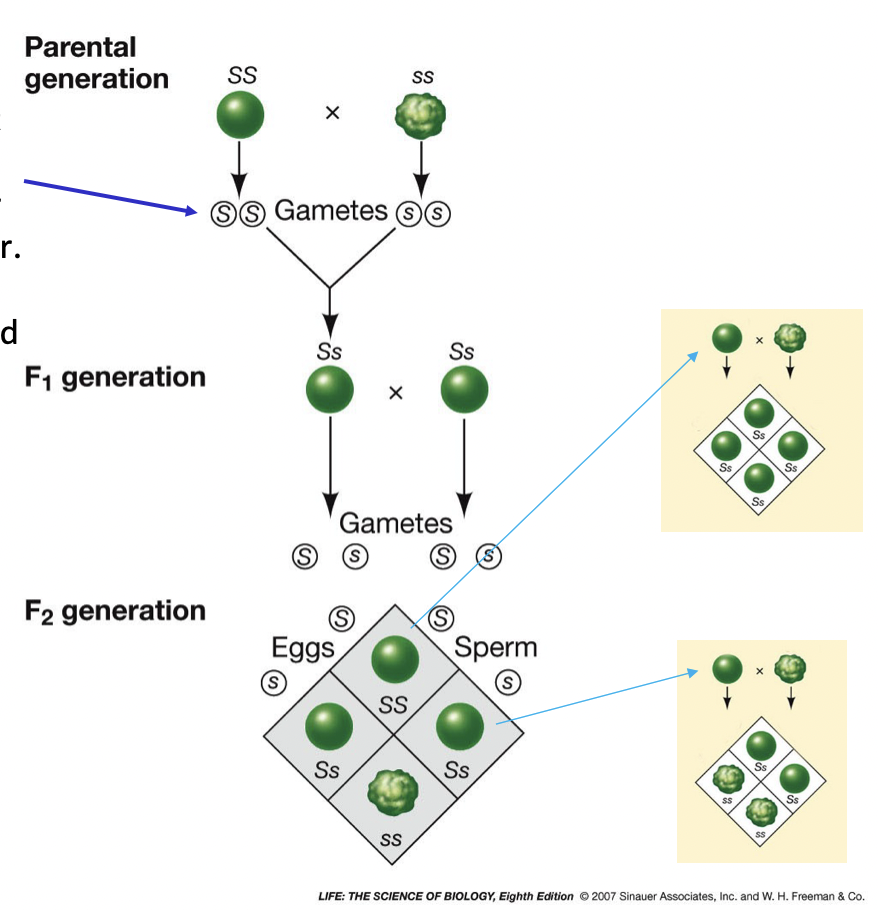
67
New cards
Genetic terms for unit of heredity, different flavours, having two of the same allele, have two of different alleles
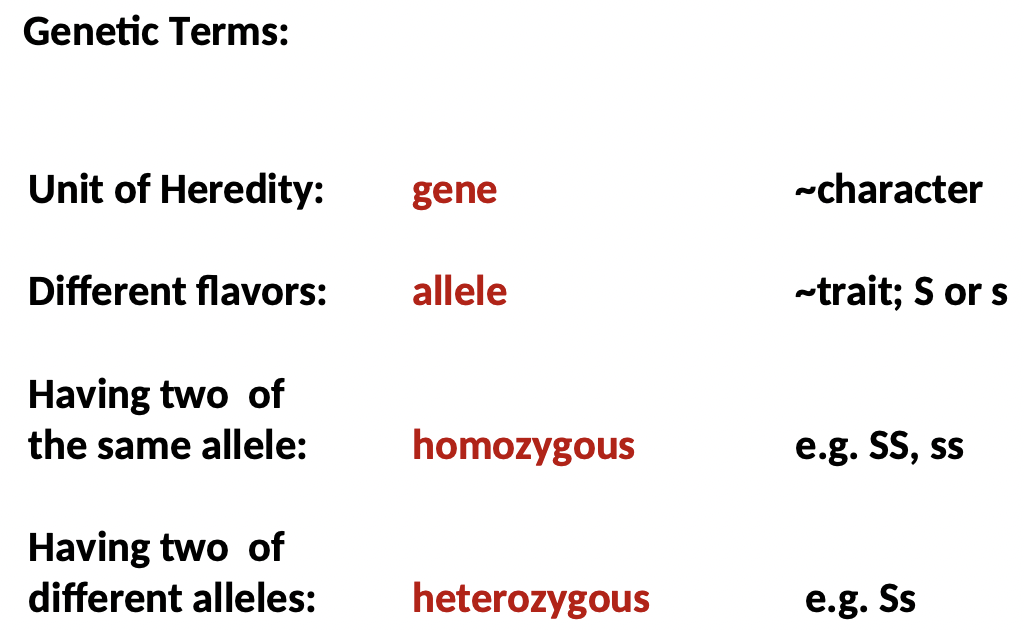
68
New cards
Law of Segregation
* Only one of the 2 gene copies present in an organism is distributed to each gamete that it makes
* Allocation of the gene copies is random
* Allocation of the gene copies is random
69
New cards
Second Rule of Probability
* The probabilities of mutually exclusive events sum
* Ex. probability homozygous round: 1/4, probability of heterozygous round: 1/2, so probability round: 3/4
* Ex. probability homozygous round: 1/4, probability of heterozygous round: 1/2, so probability round: 3/4
70
New cards
Independent Events
If the 1st coin is heads it has no influence on whether or not the 2nd coin will be heads or tails.
71
New cards
Mutually Exclusive Events
If both can’t happen at the same time then the probability of either event occurring is the sum of their individual probabilities.
72
New cards
Genotype
The set of alleles an organism has.
73
New cards
Phenotype
The set of traits an organism displays.
74
New cards
Genotype vs. Phenotype
Genotype determines phenotype, but because of dominance phenotype may not uniquely determine genotype.
75
New cards
How can you tell if two plants with the same PHENOTYPE have the same GENOTYPE (Ss or SS)?
Test cross: Cross the plant with the dominant phenotype with the plant with the recessive phenotype (i.e. must be ss)
* This will give you two different results based on the genotype of the plant exhibiting the dominant phenotype
Result: If it is homozygous you get all progeny with the dominant phenotype, if it is heterozygous you get progeny with 50% recessive and 50% dominant phenotype
* This will give you two different results based on the genotype of the plant exhibiting the dominant phenotype
Result: If it is homozygous you get all progeny with the dominant phenotype, if it is heterozygous you get progeny with 50% recessive and 50% dominant phenotype
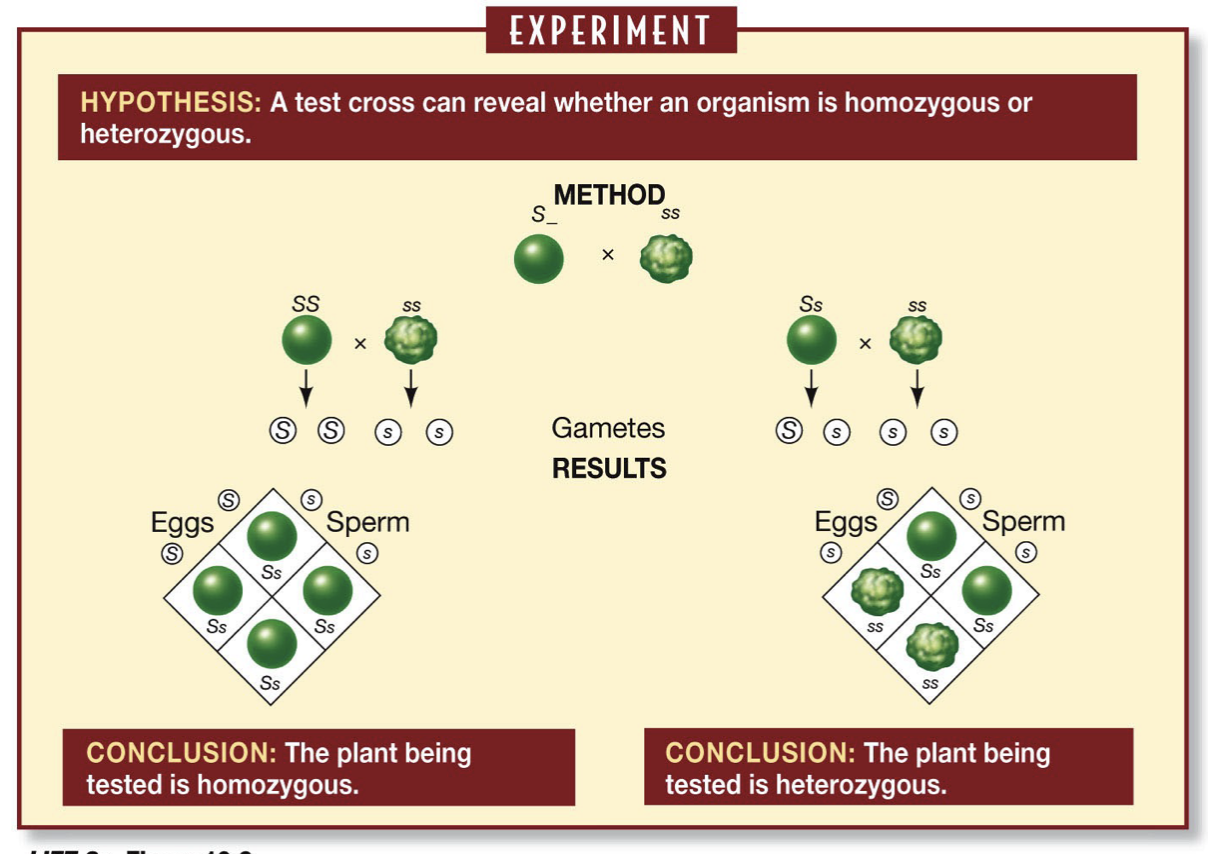
76
New cards
Dihybrid Cross and Mendel
* Used to find if colour is linked to roundness
* Result: They assorted independently, which further supported his idea that heredity consisted of discrete units that moved into the gametes independently
* Result: They assorted independently, which further supported his idea that heredity consisted of discrete units that moved into the gametes independently
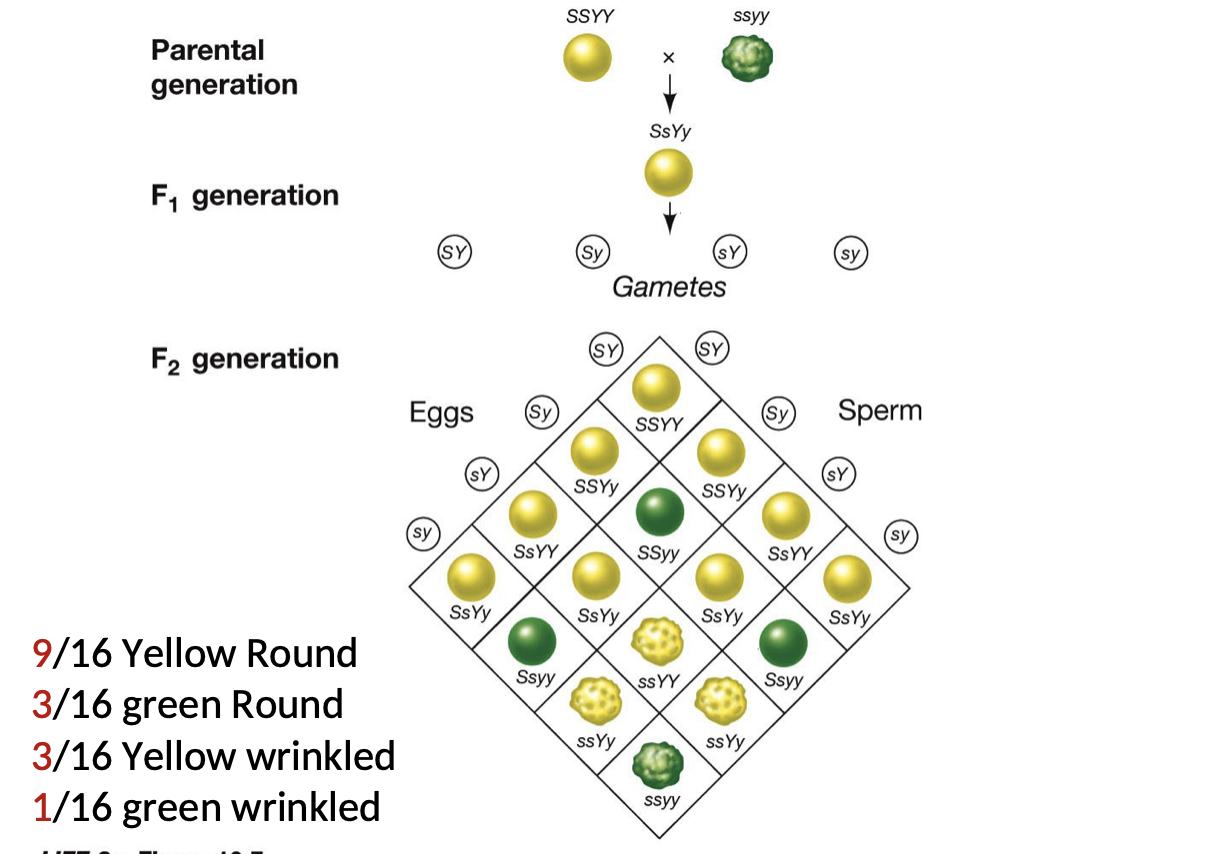
77
New cards
Link Between Meiosis and Heredity
* Discovery of meiosis validated Mendel’s ideas
* Genes are on chromosomes, one gene on each homolog, 2 homologs in each cell, thus 2 genes in each cell
* Homologs similar not identical, could contain different alleles of a gene
* Homologs separated randomly at meiosis 1, so 1 to each gamete
* Independent assortment makes sense if the genes were on different chromosomes since there’s 2 ways 2 pairs of homologs could line up on the metaphase plate of Meiosis 1
* Genes are on chromosomes, one gene on each homolog, 2 homologs in each cell, thus 2 genes in each cell
* Homologs similar not identical, could contain different alleles of a gene
* Homologs separated randomly at meiosis 1, so 1 to each gamete
* Independent assortment makes sense if the genes were on different chromosomes since there’s 2 ways 2 pairs of homologs could line up on the metaphase plate of Meiosis 1
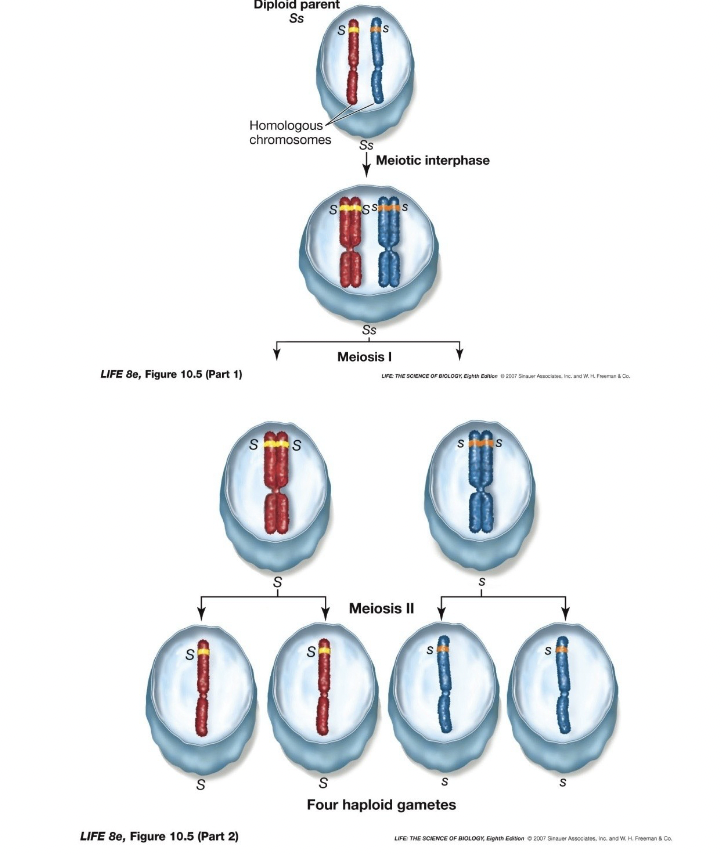
78
New cards
Sex Chromosomes
* Women are XX men are XY
* Males are heterozugous and females are homozygous recessive
* Maleness is dominant over femaleness
* Males are heterozugous and females are homozygous recessive
* Maleness is dominant over femaleness
79
New cards
Proof that maleness is dominant
* People with too many or too little sex chromosomes because of non-disjunction are XO (female) or XXY (male)
* The gene for maleness is called SRY, on the Y chromosome
* The gene for maleness is called SRY, on the Y chromosome
80
New cards
Number of Gamete Genotypes in a Punnet Square
Number of Gamete Genotypes in a Punnet Square = 2^n
n = the number of different genes under consideration
n = the number of different genes under consideration